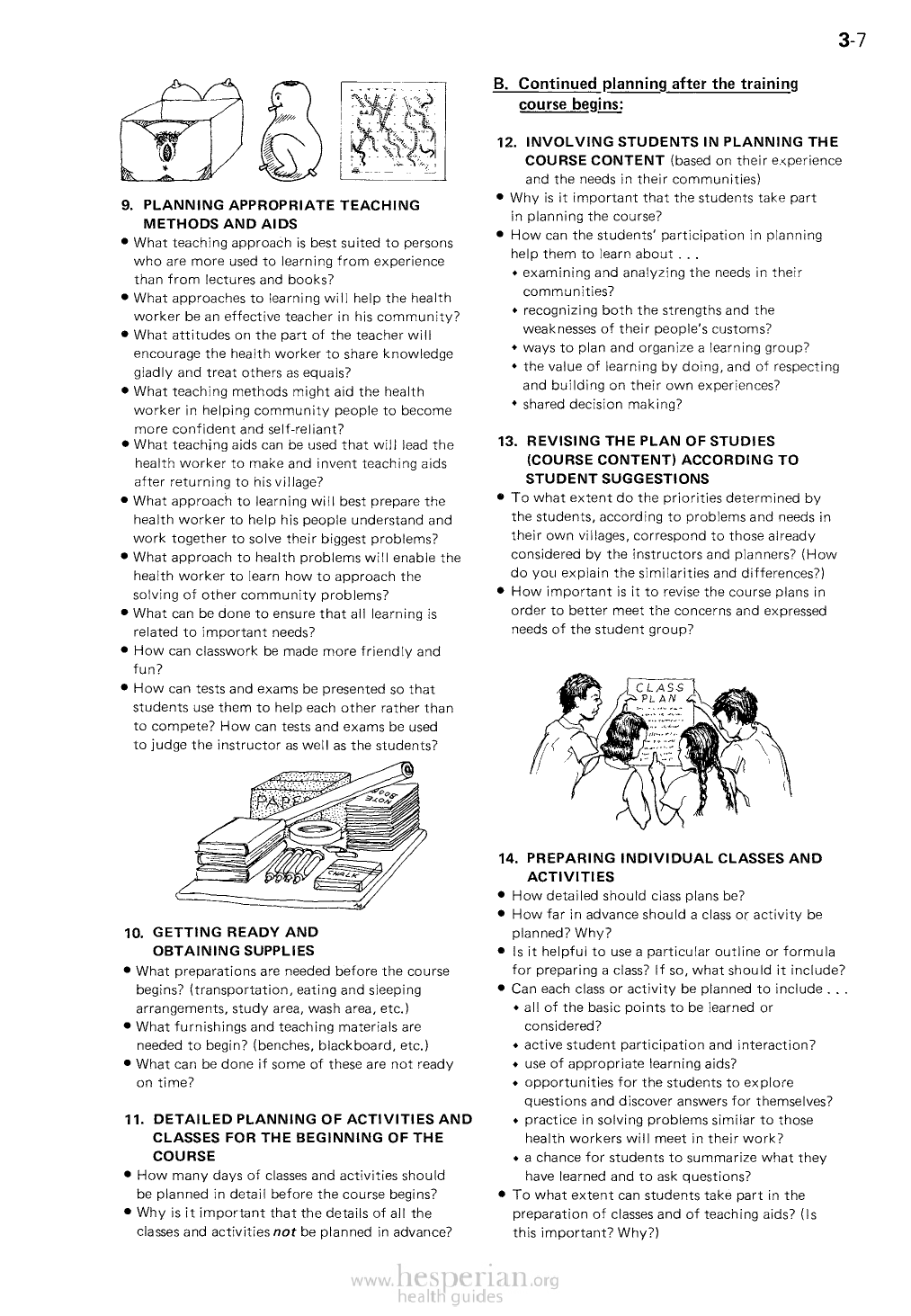
3-7
B. Continued planning after the training
course begins:
9. PLANNING APPROPRIATE TEACHING
METHODS AND AIDS
• What teaching approach is best suited to persons
who are more used to learning from experience
than from lectures and books?
• What approaches to learning will help the health
worker be an effective teacher in his community?
• What attitudes on the part of the teacher will
encourage the health worker to share knowledge
gladly and treat others as equals?
• What teaching methods might aid the health
worker in helping community people to become
more confident and self-reliant?
• What teaching aids can be used that will lead the
health worker to make and invent teaching aids
after returning to his village?
• What approach to learning will best prepare the
health worker to help his people understand and
work together to solve their biggest problems?
• What approach to health problems will enable
the health worker to learn how to approach the
solving of other community problems?
• What can be done to ensure that all learning is
related to important needs?
• How can classwork be made more friendly and
fun?
• How can tests and exams be presented so that
students use them to help each other rather than
to compete? How can tests and exams be used
to judge the instructor as well as the students?
12. INVOLVING STUDENTS IN PLANNING THE
COURSE CONTENT (based on their experience
and the needs in their communities)
• Why is it important that the students take part in
planning the course?
• How can the students’ participation in planning
help them to learn about. . .
♦♦ examining and analyzing the needs in their
communities?
♦♦ recognizing both the strengths and the weaknesses
of their people’s customs?
♦♦ ways to plan and organize a learning group?
♦♦ the value of learning by doing, and of respecting and
building on their own experiences?
♦♦ shared decision making?
13. REVISING THE PLAN OF STUDIES
(COURSE CONTENT) ACCORDING TO
STUDENT SUGGESTIONS
• To what extent do the priorities determined by the
students, according to problems and needs in their own
villages, correspond to those already considered by
the instructors and planners? (How do you explain the
similarities and differences?)
• How important is it to revise the course plans in
order to better meet the concerns and expressed
needs of the student group?
10. GETTING READY AND
OBTAINING SUPPLIES
• What preparations are needed before the course
begins? (transportation, eating and sleeping
arrangements, study area, wash area, etc.)
• What furnishings and teaching materials are
needed to begin? (benches, blackboard, etc.)
• What can be done if some of these are not ready
on time?
11. DETAILED PLANNING OF ACTIVITIES AND
CLASSES FOR THE BEGINNING OF THE
COURSE
• How many days of classes and activities should
be planned in detail before the course begins?
• Why is it important that the details of all the
classes and activities not be planned in advance?
14. PREPARING INDIVIDUAL CLASSES AND
ACTIVITIES
• How detailed should class plans be?
• How far in advance should a class or activity be
planned? Why?
• Is it helpful to use a particular outline or formula for
preparing a class? If so, what should it include?
• Can each class or activity be planned to include . . .
♦♦ all of the basic points to be learned or
considered?
♦♦ active student participation and interaction?
♦♦ use of appropriate learning aids?
♦♦ opportunities for the students to explore questions
and discover answers for themselves?
♦♦ practice in solving problems similar to those health
workers will meet in their work?
♦♦ a chance for students to summarize what they have
learned and to ask questions?
• To what extent can students take part in the preparation
of classes and of teaching aids? (Is this important?
Why?)